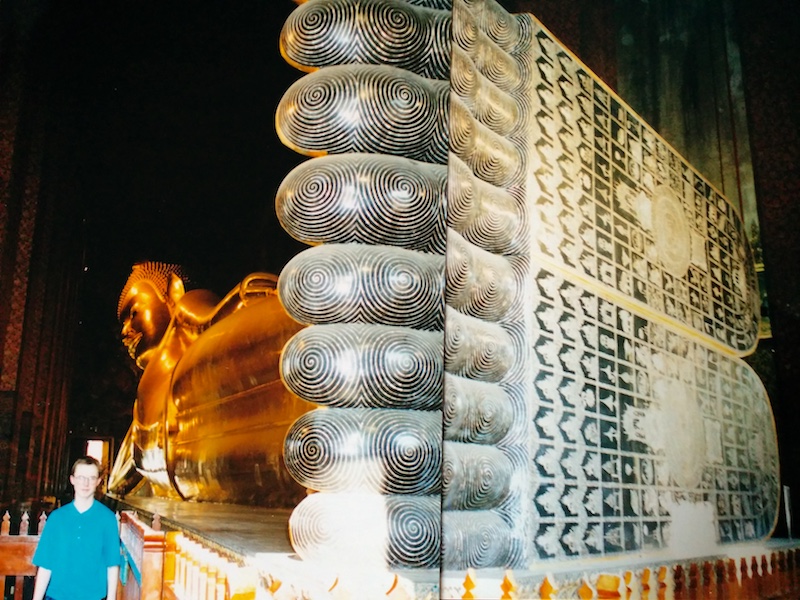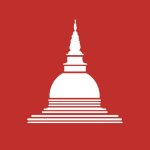Parallel to the shore
Even while learning spells for invisibility, or getting a tattoo of protection from the war-goddess Marishiten, I never really considered myself “into” Buddhism. It was always a peripheral topic to my main interest in Asia and the martial arts.
I don’t really remember a time where Buddhism was unknown to me, even growing up in small town Canada, nestled in the Rocky Mountains surrounded by primarily rural white Anglo Protestant people. For my social studies credit in grade 10 I forwent learning about the Canadian political system to take Asian Studies. That class covered a lot, but I was able to gain a high level understanding of Buddhism: the Four Noble Truths, the Eightfold Path, the difference between the Theravada and Mahayana traditions. Here is a picture of me, at age 16, by the Sleeping Buddha at Wat Pho, a famous statue in Bangkok. I remember visiting a Buddhist monastery in southern Thailand at the time, and being impressed with the monks there, but I never seriously thought about what they were actually trying to do.

Later, in my twenties, when I was seriously committed to learning classical Japanese martial arts, I was exposed to mikkyō and Shingon, and of course Zen. However we were only learning about Buddhist teachings in the narrow sense of how it served the Japanese warrior on the battlefield (I wrote a paper about this for a class, if you want to learn more). Symbolism, spells, basic meditation — the classical martial arts (and even the modern ones) are rich with Buddhist esoterica. But we spent no time on the actual teachings of the Buddha. We were there to learn how to fight.
Changing direction
Oddly enough, it was helping Syrian refugees that got me thinking about Buddha again. We were discussing Islam, and a friend talked about Karen Armstrong and recommended her biography of Buddha. From there my interest was re-ignited and I started looking more at meditation, especially mindfulness practice. I learned about Mindfulness Based Stress Reduction and the work of Jon Kabat-Zinn with terminally ill patients. Then I finally finished Bhante G’s Mindfulness in Plain English, which I had bought 6 years previous but only half-read.
So, the modern mindfulness movement was my gateway to actually learning about Buddhism. I think it is for many people in the West. But for me, it goes deeper. Our thinking on minimalism (especially danshari) is heavily influenced by Buddhist thought. Thus, rather than merely being a peripheral cultural legacy, Buddhism started to take center stage in how I live my life each day. My interest started to deepen even more.
In the spring of 2016 we went to Japan for the 13th anniversary of my wife’s grandmother’s death. I decided to take the opportunity to learn more about Jōdo Shinshū, the largest Buddhist sect in Japan and the one my family over there is part of. I had made lots of visits to temples and graveyards and participated in a number of ceremonies over the years I lived in Japan — all without knowing what really was going on. I listened to the Great Courses on Buddhism lectures for some historical context, and continued listening to guided meditations in an attempt to develop my own daily practice.
Then, my wife told me about the lump.
A bump in the road
The doctors thought it could be a sarcoma, a cancer of the muscle tissue. Getting closer to middle age the possibility of cancer is something everyone is aware of, but nobody is prepared for. That said, it is amazing that I had spent the months leading up to this discovery learning about MBSR and how it helped cancer patients. My investigation into meditation and Buddhism became more serious. Well, seriously enough to read a comic book about the Buddha I guess. 😅
While we were in limbo regarding the diagnosis, we looked at local MBSR programs and also applied to the meditation retreat at Birken Forest Monastery. Unfortunately we were waitlisted and could not go (this year I applied at 7am on the day registration opened!). I started casting about for more local options to no avail.

Working for others, anti-materialism, examining my own “monkey mind”, and considering sickness, death and impermanence. I was getting it from all sides.
The real journey begins
Eventually, the cancer scare abated, and as we got more eyes on the problem we found out the lump was in fact an arteriovenous malformation (AVM). Not great news, but not life-threatening. However, even though the scare had passed, my interest in Buddhism continued to grow.
On the next trip to Japan, last winter, I went to some of the most famous Zen temples and sat. I continue to read more books.  I have binged on the Wisdom Podcast (a great resource!) and other podcasts and dharma talks. I use the Insight Timer meditation app. I am still kind of a “Wikipedia Buddhist” but I feel my understanding has progressed a lot, especially considering I am doing it alone. But I know that I need to find a real teacher. I have so many philosophical and political questions, and I need a proper framework to truly progress. This is one of the reasons I have not been writing so much lately — it is so early in the journey and all I have are a lot of questions and not a lot of conclusions. There is nothing worthy of sharing. I have been in learning/introspection mode for a while. This summer I plan to go to Birken and hopefully meet with Ajahn Sona. In the meantime I am looking to take some online classes and hope to connect with teachers online. I have decided that this is a path I want to pursue seriously.
I have binged on the Wisdom Podcast (a great resource!) and other podcasts and dharma talks. I use the Insight Timer meditation app. I am still kind of a “Wikipedia Buddhist” but I feel my understanding has progressed a lot, especially considering I am doing it alone. But I know that I need to find a real teacher. I have so many philosophical and political questions, and I need a proper framework to truly progress. This is one of the reasons I have not been writing so much lately — it is so early in the journey and all I have are a lot of questions and not a lot of conclusions. There is nothing worthy of sharing. I have been in learning/introspection mode for a while. This summer I plan to go to Birken and hopefully meet with Ajahn Sona. In the meantime I am looking to take some online classes and hope to connect with teachers online. I have decided that this is a path I want to pursue seriously.
Now, I guess you can say, I am finally getting “into” Buddhism.

